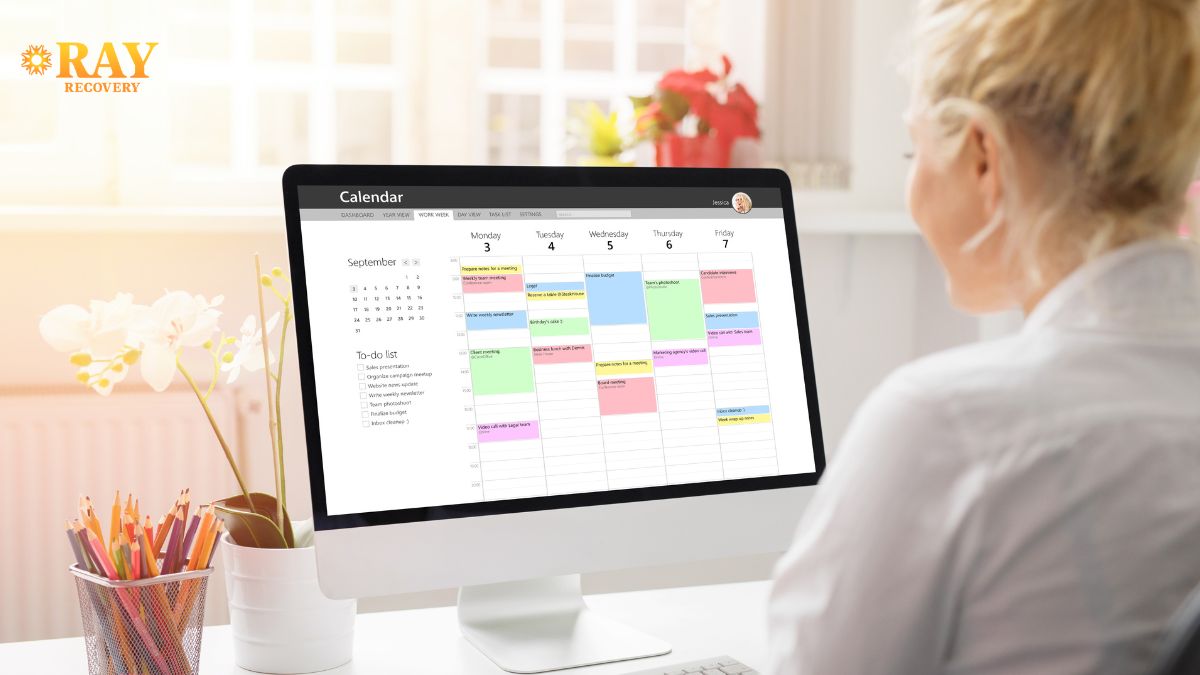Key Points:
- Create a work-friendly IOP schedule by mapping your weekly tasks, choosing sessions that avoid peak work hours, and coordinating with your employer for flexible leave.
- Most IOPs offer morning, afternoon, or evening tracks.
- Consistent routines, childcare planning, and brief post-session practice help therapy fit your routine.
Work and recovery can clash when meetings, shifts, and family duties fill every hour. Intensive Outpatient Programs offer a structured path that does not remove you from daily life. The goal is a work friendly IOP that fits your schedule so you can keep income, protect privacy, and build steady skills.
In the sections below, you will know how to plan hours, talk to your boss, and set up simple systems that make treatment stick day to day.

What Exactly Is IOP for Working Adults?
Intensive Outpatient Program (IOP) provides structured therapy in set blocks across the week. Programs include group therapy, individual sessions, and skills practice. Adults attend several times weekly in the late afternoon, evening, or early morning, or a mix, which helps when you want iop while working.
IOP hours sit in a range that is realistic for employees. Standards based on ASAM Level 2.1 place adults at 9 to 19 hours per week across three to five days. That span gives enough therapeutic intensity without removing you from work entirely.
IOP works for many job types. Office workers can take early or late sessions. Retail, healthcare, and logistics staff can join split or weekend groups. Both union and salaried employees qualify for medical leave when required.
Expect these building blocks:
- Group therapy three to four days a week in two- to three-hour blocks.
- One individual therapy hour weekly, plus medication visits if needed.
- Skills practice tasks at home between sessions.

Step 1: Map Your Real Week Before You Schedule
Time mapping helps you see where treatment fits without hurting pay or sleep. Start with a blank week, add fixed tasks like commute, meals, and care, then mark meetings you can’t miss.
Build your map in layers:
- Layer 1: Work shifts, start/stop times, locations, and commute windows.
- Layer 2: Family tasks, school runs, caregiving, and must-do errands.
- Layer 3: Sleep targets and gym time that support recovery energy.
You’ll start to see patterns in your schedule. Maybe a few late afternoons or early mornings are open, or a weekend slot works best, which can pair well with a virtual IOP. If your shifts change, make two maps, one for each rotation, so your counselor can match both.
Common fixes when the map looks tight:
- Swap one shift per week with a teammate and lock the swap for 12 weeks.
- Move one recurring meeting to asynchronous updates.
- Convert one commute day to remote work if your role allows it.
Step 2: Choose a Program Schedule That Actually Fits
Program menus often include morning, afternoon, and evening tracks, and some offer an executive IOP that protects work time.
Compare tracks with these filters:
- Start and end times: Do they avoid your rush hours and key meetings?
- Travel load: Can you reach the site in under 35 minutes door-to-door?
- Hybrid access: Are video groups available on heavy workdays?
One national report shows the need is large, with 48.5 million people experiencing a substance use disorder in 2023. That scale pushed many providers to widen scheduling windows and maintain evening options that work for employees.
If you work variable shifts, ask for two linked tracks (for example, Mon/Wed/Fri evenings on Week A and Tue/Thu/Sat mornings on Week B). Most programs can pre-clear both tracks in your plan so you keep a full dose of hours across the cycle.
Good signals you found the right fit:
- Consistent times across the week that do not cut into primary work blocks.
- A backup slot reserved for weeks with unexpected overtime.
- Access to brief check-ins on heavy deadlines so momentum continues.

Step 3: Coordinate With Your Employer Without Oversharing
HR policies often protect time for treatment when a clinician certifies medical need. You decide how much detail to share. Many employees only disclose the need for health appointments during specific windows.
Know your options before you meet HR:
- FMLA: Up to 12 workweeks of job-protected leave in a 12-month period for treatment with a licensed provider or provider-referred care. Absences due to use itself do not qualify.
- Paid time off: Use a small block each week to cover a travel buffer.
- Adjusted hours: Shift start or end by 60–90 minutes on IOP days.
Paperwork that helps:
- A provider letter listing the recurring days and time window
- A one-page schedule plan that shows how tasks will be covered
- A list of blackout dates you already see on the work calendar
Step 4: Build a Work Friendly IOP Routine You Can Repeat
Planning starts with small repeatable habits around each session. The goal is to lower friction so therapy days feel like any other part of your week.
Lock in simple anchors:
- Same-day pack: ID, water, quick snack, and notebook waiting by the door.
- Commute cue: A short playlist or podcast for the ride so your brain shifts gears.
- Skill slot: A 15-minute practice window after each session to apply one tool at home.
Explain your schedule as set appointments that protect health, just like physical therapy. Keep a family calendar in view so others can support rides and meals on group therapy days. Hold a fixed bedtime on the nights before sessions. If caffeine use spikes late in the day, pull it back after 2 p.m. to avoid restless nights that lead to missed groups.
Step 5: Plan for Commute, Childcare, and Meals
Real-life logistics decide whether your plan holds. Solve these three areas early so you avoid last-minute scrambles.
Commute planning:
- Choose a route that avoids bottlenecks and confirm parking rules.
- Keep a rideshare gift card as a backup for car trouble days.
- Set a 30-minute buffer before group start, then shorten later if on time.
Childcare planning:
- Line up one primary caregiver and one backup for group days.
- Use a shared calendar with alerts for pickups and drop-offs.
- Pre-pack school items the night before therapy blocks.
Meal planning:
- Batch two quick dinners early in the week to cover therapy nights.
- Stock ready proteins and fruit for post-group hunger.
- Keep hydration steady during sessions to reduce headaches.
Step 6: Protect Work Performance While You’re in Care
Performance fears often hold people back from IOP. You can support your role while in treatment by changing the way work flows through the week.
Tactics that keep output steady:
- Front-load deep work on non-IOP days and save admin for therapy days.
- Set brief daily check-ins by message instead of extra meetings.
- Use templates for routine tasks so you reduce decision load.
If your job tracks outcomes, document your plan and progress. Share metrics that show deadlines met and response times intact. That record protects your role if any question comes up.

Step 7: Know What Results to Expect From IOP
Treatment aims include fewer cravings, better mood stability, and stronger coping tools at work and home. Evidence shows IOP can deliver outcomes on par with inpatient treatment for many people with lower withdrawal risk and less severe symptoms.
Adults also report fewer missed days once skills settle in. Many describe sharper focus at work, better sleep, and less conflict at home. Measure your own gains with quick weekly checklists: sleep hours, cravings, stressful events handled, and work tasks completed on time.
Step 8: Use Simple Tools, Templates, and Scripts
Small tools keep your plan on track without extra effort. Pick just a few and use them every week.
Helpful tools for busy weeks:
- A shared calendar with color blocks for sessions, commutes, and tasks
- A notes app with one page per week for triggers and skills that worked
- A 15-minute weekly review on Sunday to reset the plan
Short scripts that reduce stress:
- Supervisor: “I have recurring health appointments on Mon/Wed/Fri 5–7 p.m. I will complete my deliverables by 3 p.m. on those days and reply after 7:30 p.m.”
- Coworker: “I swapped Tuesday coverage while I attend appointments on Wednesdays. Thanks for trading Fridays; I will cover your morning standups.”
- Family: “These are the three evenings I am out. Here are the pre-made meals and school items.”
Step 9: Plan for Setbacks Without Losing Momentum
You can never tell when your child gets sick, you have overtime, or there are transit delays. Build a small recovery plan so one miss does not snowball.
Create a fallback ladder:
- Ask your program about one flex group you can use each week if needed.
- Keep one telehealth option on heavy weeks if your program allows it.
- If you miss a day, add a brief skills call or self-practice to close the gap.
A clear schedule plus quick recovery steps prevents gaps from growing. Over a month, those small saves add up to full exposure to the core therapy skills that move you forward.

Step 10: Understand Hours, Safety, and Scope
Clear expectations reduce strain at work and home. Programs teach relapse prevention, coping skills, and crisis planning within broader mental health services. Some offer medication visits on-site.
Scope fits many roles. Teachers might use an early evening track after class. Warehouse staff might take a morning block before swing shift. Office staff can aim for late afternoon groups that end before family time.
Step 11: Know Your Rights and Protections
Job-protected leave may apply when care is medically necessary. FMLA allows qualifying employees to take leave for treatment with a licensed provider. Absence due to use itself does not qualify.
Your HR team can guide you on how to apply and how to structure intermittent leave for recurring sessions. Many employees also confirm coverage through Tricare benefits or similar plans.
If you worry about stigma, keep disclosures minimal and focus on logistics. Share times, coverage plans, and deadlines. Most supervisors care about output and predictability above all else.
Step 12: Track Progress and Adjust Your Plan
Check in with your counselor every two weeks about schedule fit. If commute stress is high, move one day to virtual if offered. If evening groups leave you wired, try a morning track and a short walk after the group to settle your mind before work.
Set a simple scorecard: cravings (0–10), sleep hours, work tasks done, and number of skills used in real situations. Celebrate small wins, like handling a tough meeting without a spiral or leaving early enough to arrive on time to group twice in a row.
Frequently Asked Questions
Can you work while in IOP?
Yes. You can work while in IOP because programs are designed to provide care alongside daily responsibilities. Most IOPs run 9 to 19 hours per week across multiple days, with evening and morning tracks available. HR may approve intermittent leave to help you attend without risking your job.
Is PHP or IOP better?
PHP is better when symptoms or risks are higher and more daily structure is needed. IOP is better when 9 to 19 hours per week fits your needs and you can practice skills between sessions. Clinicians choose based on safety, withdrawal risk, support at home, and work responsibilities.
Are IOP programs effective?
Yes. IOP programs are effective for people with lower withdrawal risk and moderate symptoms. Studies show outcomes can match inpatient care when attendance is consistent and skills are used between sessions. Programs with relapse prevention, coping tools, and family support lead to stronger, lasting gains.
Take the Next Step Toward a Work-Ready Plan in Ohio
Work friendly IOP scheduling can protect your paycheck, support your family rhythm, and strengthen recovery skills at the same time. Outpatient addiction treatment in Ohio gives you options to match your real week, whether you need morning, afternoon, or evening blocks.
At Ray Recovery, we offer PHP, IOP, OP, dual-diagnosis care, and medication-assisted treatment so your plan can adjust as your needs change. Contact us to map a schedule that fits your routine and keeps your progress steady, then start the first week with clear goals and a support team behind you.


